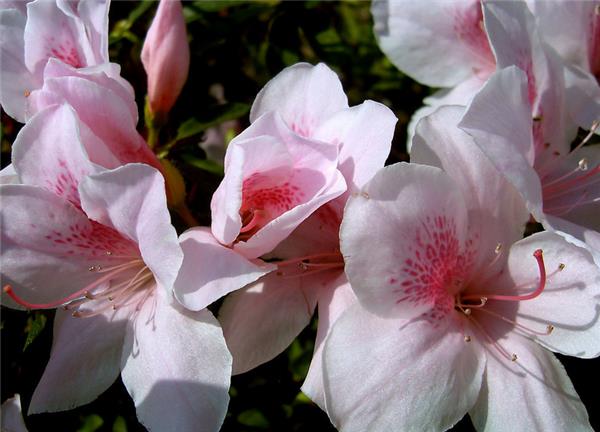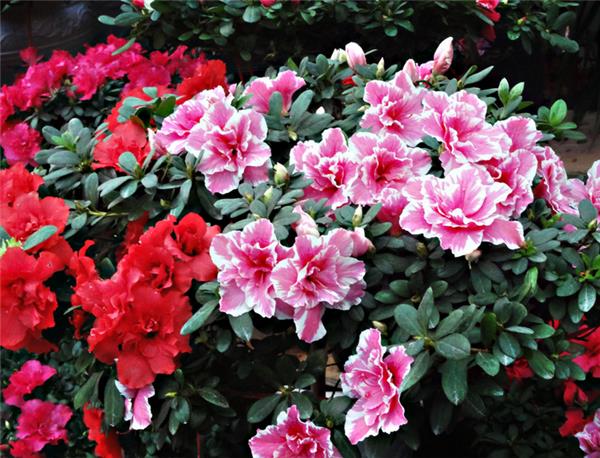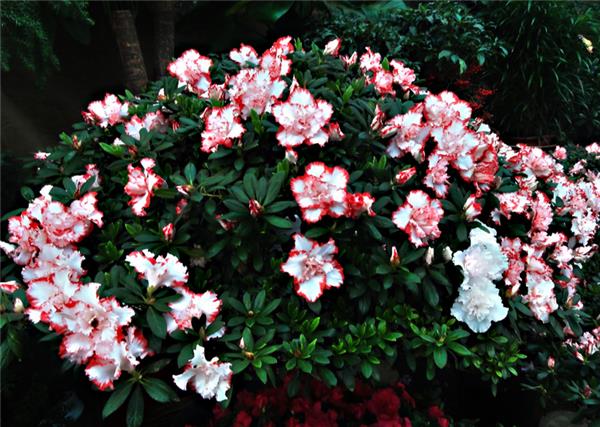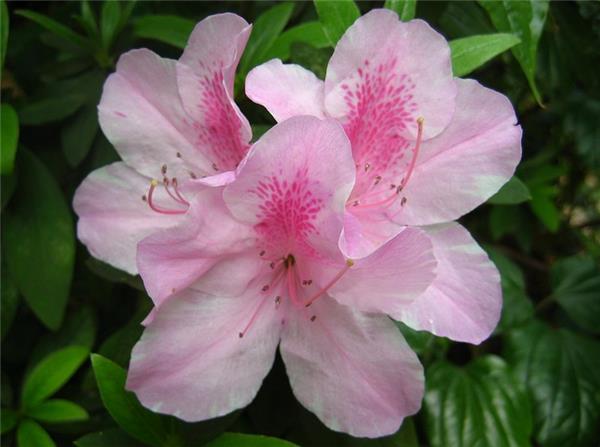Culture method of rhododendron
Azalea luxuriant leaves, beautiful and colorful, strong germination, resistance to pruning, unique root piles, is an excellent bonsai material, the following we will introduce in detail the methods of rhododendron culture.

Culture method of rhododendron
1. Selection of flowerpots for rhododendron culture
(1) flowerpot requirements: muddy flowerpots, plastic pots, porcelain pots, pottery pots and so on can be used.
(2) the size of flowerpot: the size of flowerpot for planting rhododendron seedlings is the same as the crown diameter of seedlings, the size of flowerpot at seedling stage is 3 × 4 of its crown diameter, and the size of flowerpot at seedling stage is 1 / 2 of its crown diameter.
two。 Preparation of pot soil for rhododendron culture
Rhododendron prefers acidity (pH value 4.5-5.5), loose, well-drained soil. Avoid calcareous alkaline soil, avoid clayey soil. The formula for home cultivation is as follows: Belgian rhododendron: rotten leaf soil: peat soil: sand = 5 virtual 2vl 3; spring and summer rhododendron: garden soil: peat soil: sand = 3:5:2. Mix with proper amount of bone powder and stir evenly.

3. Temperature and light requirements of rhododendron culture
Potted rhododendrons are generally potted from March to April in spring and can also be potted in autumn. Transplant with soil when putting on the pot, and pour water into the shade after planting.
The northern potted rhododendron is generally moved indoors in the first and middle of October and placed in the sunny place after entering the house. In the early days of the room, attention should be paid to the frequent opening of windows for ventilation. The room temperature in winter should be about 10 ℃, which should not be too high, otherwise, the physiological activity of the plant will be strengthened, a large amount of nutrients will be consumed, and the flowering and growth in the coming year will be affected. At the same time, sufficient light should be given. Leave the room after the middle and late April of the following year, when the sun is softer, should be properly shaded around noon, and should be moved to a cool and ventilated place for maintenance after summer. Because rhododendron belongs to negative flowers, it needs to be maintained in the shade in spring, summer and autumn, especially in the hot sun for a long time in summer, it is easy to cause withered and yellow branches and leaves, stagnation of growth and death of the whole plant. The time of seeing light every day in autumn should be gradually lengthened, and the shading should be stopped at the end of autumn.

4. Watering method of Rhododendron Culture
Keep the basin soil moist during the growing period, need more water during the flowering period from April to June, spray water to the ground and leaves in the high temperature season from July to August, keep the air moist, cool the temperature gradually after September, gradually reduce the water content of the basin soil, and enter the dormant period in winter. Less watering should be done.
Because the root system of rhododendron is shallow, afraid of both drought and waterlogging, improper watering, light falling leaves, heavy death, therefore, watering is one of the key measures to raise juniper flowers. Watering should be determined according to the plant season and growing period. The water consumption is more in the bud and flowering period in spring, and the watering should be timely. If the pot is dehydrated, the flower will wither and the florescence will be shortened. In this period, it is appropriate to keep the basin soil moist. In summer, rhododendron branches and leaves grow vigorously, the temperature is high, and water evaporates fast. in addition to watering once a day, water should be replenished at any time. If you are a little negligent, making the basin soil too dry will cause the leaves to turn yellow, curl the leaf center, and even dry up and die.
Because the cuckoo likes to be moist, it is necessary to spray the leaves with clear water and sprinkle water on the ground around the flowerpot in summer in order to increase the air humidity and lower the air temperature. in autumn, flower buds have been formed, the temperature is dropping day by day, and the weather turns cool. at this time, keep the pot soil dry. When the temperature is low in winter, the cuckoo is dormant or semi-dormant, and the water consumption is low, so watering should be strictly controlled. Too much water is easy to rot the roots, but in this period, the branches and leaves should be sprayed with water close to room temperature every 5 to 7 days to make the plants fresh. Rhododendron watering should pay attention to the quality of water, it is more appropriate to use Rain Water, if tap water is used, it must be stored in a container for 1-2 days before use.

5. Fertilization methods for Rhododendron Culture
The roots of rhododendron are shallow and thin, and their absorptive capacity is weak, so we must grasp the principle of "thin fertilizer and diligent application" when applying fertilizer. If the fertilizer is too thick or the raw fertilizer is not fully mature, it is easy to cause rotting roots, scorched leaves and even death. Especially for 1-and 2-year-old seedlings, we should pay more attention to the amount of fertilizer, otherwise it is easy to cause fertilizer damage.
From February to March before blooming, liquid fertilizer dominated by phosphorus should be applied every 10 to 15 days to promote large flowers, and from March to April, applying the same fertilizer to summer cuckoos can make the flowers large, good color, thick petals and long flowering period. Fertilization should be stopped during flowering, otherwise it is easy to shed flowers and long leaves, which will affect the ornamental effect; after flower fade, nitrogen-based fertilizer should be applied every 10 days or so to promote new shoots. After late July, it is the period of flower bud differentiation of rhododendron. Liquid fertilizer dominated by phosphorus should be applied every 10 to 15 days to promote flower bud differentiation. No fertilizer is needed during winter dormancy, so topdressing should be stopped.
6. Pruning methods of Rhododendron Culture
Rhododendron has strong germination, many branches and dense branches. after flowering, dense branches, weak branches, withered branches, diseased branches, residual branches, cross branches and long branches should be cut off to facilitate ventilation and light. Do not cut short the reserved branches. Because the leaves of azaleas are mostly clustered at the top of the branches, a new branch and a cluster of new leaves will grow after flowering, and the old leaves will fall off immediately, and then the terminal bud begins to differentiate into flower branches in the coming year. If this branch is cut off, it will affect the number of flowers in the following year.
To promote flower bud differentiation. No fertilizer is needed during winter dormancy, so topdressing should be stopped.
6. Pruning methods of Rhododendron Culture
Rhododendron has strong germination, many branches and dense branches. after flowering, dense branches, weak branches, withered branches, diseased branches, residual branches, cross branches and long branches should be cut off to facilitate ventilation and light. Do not cut short the reserved branches. Because the leaves of azaleas are mostly clustered at the top of the branches, a new branch and a cluster of new leaves will grow after flowering, and the old leaves will fall off immediately, and then the terminal bud begins to differentiate into flower branches in the coming year. If this branch is cut off, it will affect the number of flowers in the following year.
Related
- Wuhan Hospital Iron Tree Blooming Result Was Instantly Frightened by the Gardener Master
- Which variety of camellia is the most fragrant and best? Which one do you like best?
- What is the small blue coat, the breeding methods and matters needing attention of the succulent plant
- Dormancy time and maintenance management of succulent plants during dormancy
- Minas succulent how to raise, Minas succulent plant pictures
- What are the varieties of winter succulent plants
- How to raise succulent plants in twelve rolls? let's take a look at some experience of breeding twelve rolls.
- Attention should be paid to water control for succulent plants during dormant period (winter and summer)
- Watering experience of twelve rolls of succulent plants
- Techniques for fertilizing succulent plants. An article will let you know how to fertilize succulent plants.



